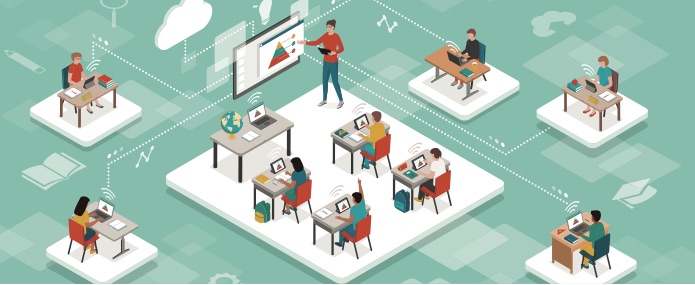Flipped lessons and blended learning benefits those at home and in schools says international school teacher James McAleese of Gems Winchester
What lessons can we take from the experience of distance learning during lockdown, and how can we continue to utilise EdTech and new teaching practices once schools reopen?
International schools across the UAE are now looking ahead to the new school year and starting to prepare for their phased reopening. There is still a level of uncertainty around what the classroom experience will look like in the new academic year.
We all agree that the health and wellbeing of students remains the priority, whilst ensuring that they continue to receive a high-quality education at home just as they would do in school.
The ‘new normal’ will likely involve a blended learning approach to support students who may still be based at home. This is especially important for the 15-16 year-olds in Years 10 and 11, who are at a critical stage in their education, working towards the IGCSE qualifications they take at the end of Year 11. Looking at what has worked with them is a good example of what can be done.
Providing ongoing support and reassurance for students in the 14-to-16 age group who are learning from home has been the priority for us at GEMS Winchester School, while also equipping them to transition into the next stage of their education as the academic year draws to a close.
With this in mind, we sought to create a blended learning strategy which would integrate digital resources and conventional teaching methods for an engaging and interactive student experience. The outcomes have certainly illustrated the benefits to be had!
From improving their ability to learn and self-review independently, to allowing for more personalised instruction which reflects the needs of individual learners, our results are impressive. As schools across the globe prepare to reopen, evolving our teaching practices to include more flexibility and mixed-media content might be the most valuable takeaway from this experience.
As we made the transition to home learning, we knew it would be important to deliver engaging and interactive lessons despite not being face-to-face with our students. One particularly successful tactic was to use flipped learning, which has been defined as “a pedagogical approach in which direct instruction moves from the group learning space to the individual learning space.”
Clearly, if you are moving direct instruction to the ‘individual learning space’ you need to find material that fits the curriculum and offers individualisation. Prior to the school closures, we were already encouraging teachers to use more education technology. For our students we used GCSEPod, which has a bank of three- to-five minute ‘Pod’ videos written specifically for 27 IGCSE and GCSE subjects, plus a range of tools that enable teachers to create video playlists to share, and to set work for students.
Teachers can set assignments and other learning activities available within GCSEPod with students on Microsoft Teams. Pupils enjoy chatting and sharing their ideas just as they would have done in the normal classroom, and they felt more motivated understanding exactly how the videos fit into the curriculum content.
Blended learning is an opportunity to enrich the personalised learning experience. Each pupil is different and will learn best in different ways and at different speeds.
For example, like other international schools in the UAE, we have a high proportion of learners with English as an additional language (EAL). Students therefore enjoy using audio-visual resources with subtitles, which allow them to slow down or re-watch sections as needed.
Using an online learning tool which provides instant feedback on students’ work is valuable, as it allows teachers to identify any knowledge gaps in real-time and ensure this is addressed in the next lesson.
Once schools reopen, digital resources can continue to offer a customised but independent learning experience for students preparing for exams at a time when they need it most.
Blended learning is more attuned to the way today’s young students consume and engage with content. Audio-visual revision has entertainment appeal, but also flexibility, enabling students to pause, watch and re- watch as needed to reinforce their topic understanding.
Combining this independent work with teacher-led sessions then creates a more engaging and dynamic student experience. Furthermore, blended learning enables pupils to take ownership of their study and develop key independent thinking skills, which are beneficial for their education careers and beyond.
While digital learning is not a replacement for traditional classroom teaching, it is an invaluable tool which can enhance the learning experience for students when integrated properly within the curriculum.
As schools look ahead and prepare students for the new academic year, there is much to be learnt from the experience of recent months. Blended learning can make for a more efficient and personalised learning experience, which is valuable for all pupils, but especially those involved in exam preparations.
Interactive, curriculum-based online learning which reflects the way students want to learn can help teenagers stay motivated with their learning, both at home and in the classroom.





